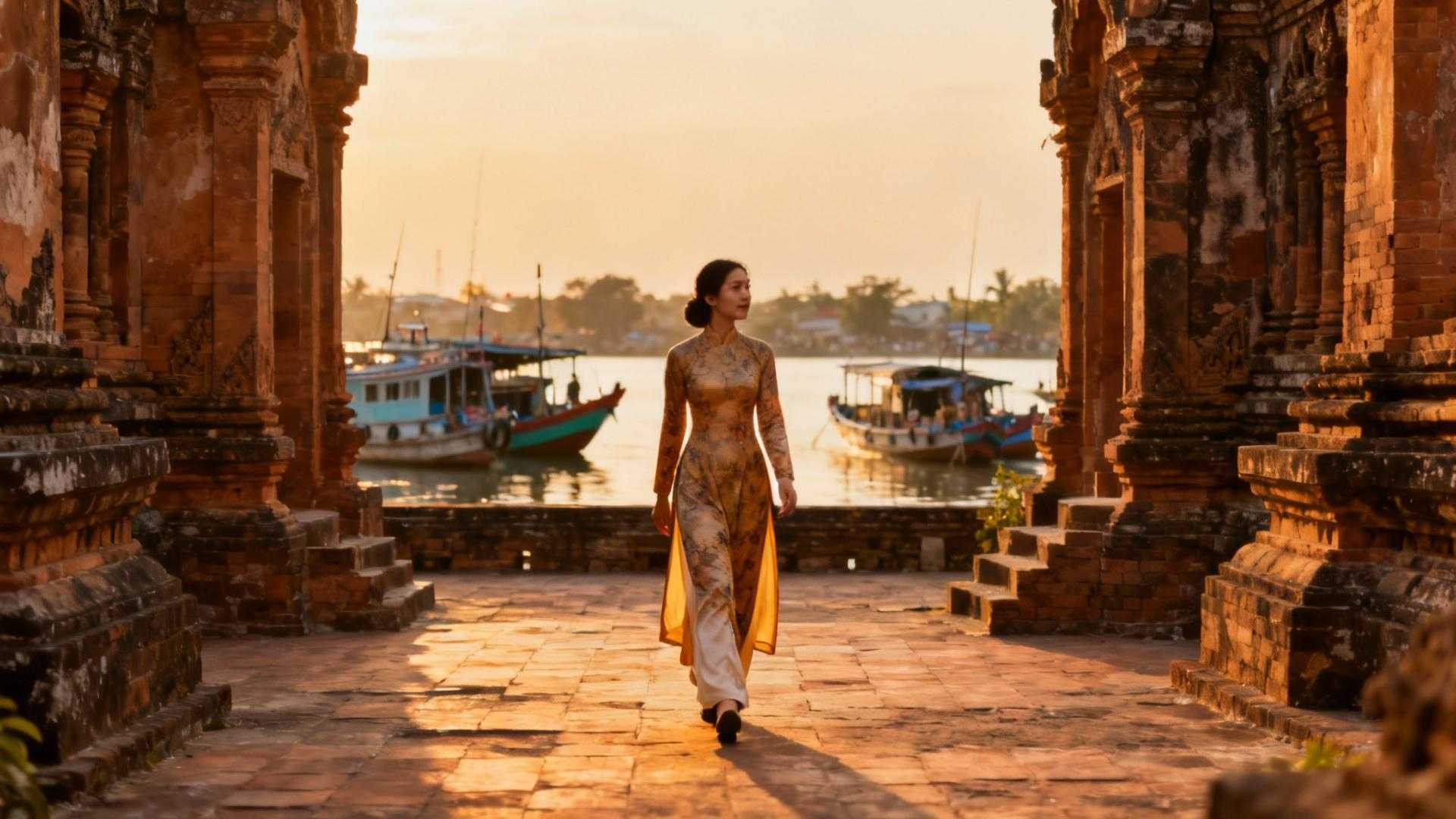In the heart of the Mekong Delta, where three nations converge at ancient river crossings, Chau Doc remains Vietnam’s most carefully guarded cultural sanctuary. This border town of 161,000 souls harbors something extraordinary that locals whisper about with protective pride: four distinct civilizations living in harmony while preserving traditions that span millennia.
Vietnamese fishermen share floating markets with Cham weavers, while Khmer monks chant alongside Chinese merchants in a cultural tapestry found nowhere else in Southeast Asia. Yet as cruise ships multiply on the Mekong and tourism revenue soars 300% across Vietnam, Chau Doc’s residents face an impossible choice between economic opportunity and cultural preservation.
The answer they’ve chosen might surprise you—and it’s why this spiritual haven remains authentically untouched despite welcoming visitors for generations.
The four-culture phenomenon that defies modern Vietnam
Ancient communities that time forgot
Cham villages in Da Phuoc and Chau Phong still weave traditional textiles using 800-year-old techniques, their wooden looms clicking rhythmically in stilted houses overlooking the Hau River. These Islamic descendants of the Champa Kingdom maintain their own language, calendar, and architectural style—mosque minarets rising beside Vietnamese pagodas in a harmony that shouldn’t exist.
Khmer temples hiding in plain sight
The Khmer community around Chau Giang operates Buddhist temples where monks conduct ceremonies in ancient Sanskrit, preserving rituals that predate Angkor Wat. Their traditional stilt houses cluster around hidden courtyards where elders still practice palm-leaf manuscript writing—a skill nearly extinct elsewhere in the region.
Sacred Sam Mountain’s protective embrace
The pilgrimage site locals call home
Sam Mountain rises 284 meters above the delta’s flatness, hosting over 200 religious structures where Vietnamese Buddhists, Cao Dai followers, and folk religion practitioners worship side by side. During the Ba Chua Xu Festival, over one million pilgrims arrive—yet locals have developed intricate systems to maintain spiritual authenticity while managing the crowds.
Hidden caves and ancient meditation chambers
Beyond the main temples, secret meditation caves carved into Sam Mountain’s limestone faces shelter monks and nuns in year-round retreat. These sacred spaces, accessible only through unmarked trails, represent the spiritual heart that locals protect most fiercely from casual tourism.
Floating villages that operate like clockwork
The Mekong’s last authentic water world
Chau Doc’s floating communities live entirely on the river—houses, schools, markets, and temples all rising and falling with seasonal floods. Unlike tourist-focused floating markets elsewhere, these 70 floating villages function as complete societies where families have lived for seven generations, raising fish beneath their homes and trading with communities that share similar protection values.
Economic systems that preserve tradition
The tra fish farming industry beneath floating houses generates $2.1 billion annually while maintaining traditional ecological practices. Families hand-feed fish twice daily, using ancestral knowledge to balance river ecosystems—a sustainable approach that mirrors other communities successfully preserving traditions.
The Cambodia border crossing that changes everything
Cultural exchange at its most authentic
Speedboats to Phnom Penh carry not just tourists but generations of cross-border families maintaining cultural connections. This daily exchange keeps traditions alive through intermarriage, shared festivals, and economic partnerships that create living cultural bridges rather than museum-piece preservation.
Border markets that tell ancient stories
The Chau Doc-Phnom Penh route follows trading paths used for over 400 years, where merchants still exchange goods using traditional river boats and age-old negotiation customs. These markets operate with spiritual significance that locals protect like sacred thresholds.
Chau Doc’s residents have discovered something remarkable: selective sharing of their cultural treasures actually strengthens rather than dilutes traditions. By welcoming respectful visitors while maintaining authentic practices, they’ve created a sustainable model that preserves heritage while supporting 161,000 livelihoods.
Visit during October through April’s dry season when temple festivals bloom and floating markets operate at full capacity—but come with the reverence this four-culture sanctuary deserves.
Planning your respectful visit to Chau Doc
When should I visit Chau Doc for the best cultural experience?
October through April offers optimal weather and peak cultural activity. The Ba Chua Xu Festival in April attracts millions of pilgrims, while October provides perfect conditions for exploring floating villages and mountain temples.
How can I experience all four cultures respectfully?
Book community-based tours through local cultural centers that ensure your visit supports each community directly. Spend at least three days to properly experience Cham weaving workshops, Khmer temple ceremonies, Chinese merchant districts, and Vietnamese floating markets.
What makes Chau Doc different from other Mekong destinations?
Unlike Can Tho or My Tho’s tourist-focused attractions, Chau Doc’s four cultures operate as living communities rather than cultural displays. The city’s position at three national borders creates authentic cultural exchange impossible to replicate elsewhere.
Where should I stay to experience authentic local life?
Family-run guesthouses near Sam Mountain or floating homestays offer genuine cultural immersion. Prices range $15-30 nightly, with meals and cultural activities often included in community tourism programs.
How do I respect local customs while visiting sacred sites?
Dress conservatively for all religious sites, remove shoes before entering temples, and never photograph without permission. Each culture has specific protocols—local guides ensure you honor traditions while experiencing authentic spiritual practices.
